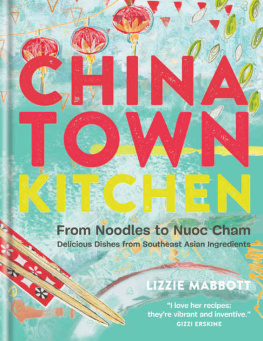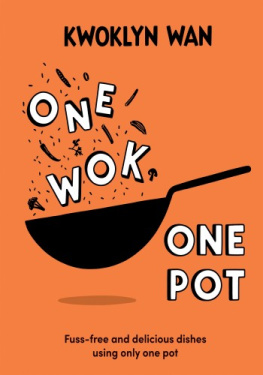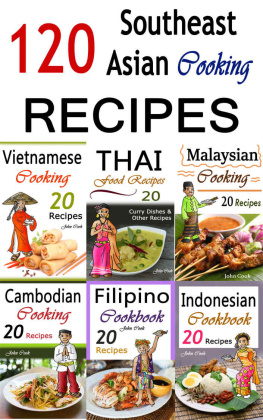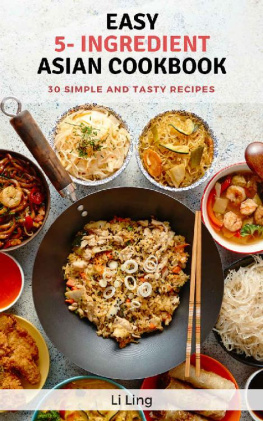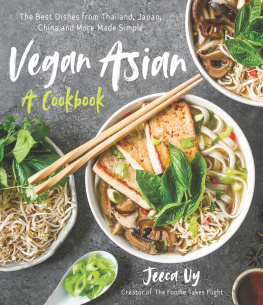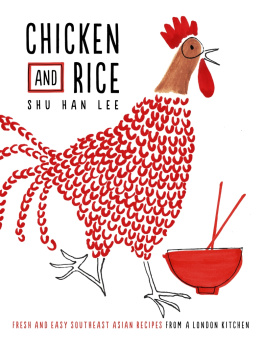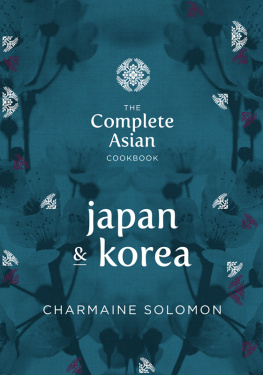

CONTENTS
HOW TO USE THIS EBOOK
Select one of the chapters from the main contents list and you will be taken to a list of all the recipes covered in that chapter.
Alternatively, jump to the index to browse recipes by ingredient.
Look out for linked text (which is underlined and/or in a different colour) throughout the ebook that you can select to help you navigate between related recipes.
Of half Chinese and half English parentage, I grew up in Hong Kong. Its a smelly, noisy and hectic city; the name translates rather romantically as fragrant harbour really, it is anything but. Most people who visit are completely overwhelmed by it. My childhood memories are tinged with the smell of food cooking street-side, mingled with traffic fumes and garbage. Add to this heady mix the whiff of petrol from the sampans and ferries gathering in said harbour, and they blend together to make an unforgettable atmosphere. In summer, the temperatures reach a high of 35C (95F) with humidity only known in sub-tropical countries; when visiting recently, as my hair turned into a birds nest, I wondered how I coped. I imagine I was less concerned about how I looked back then.
Growing up, some of my peers lived a more sterile life in townhouses in exclusive areas, their parents being ex-pats sent by their employers with expense accounts to pay the sky-high rents. When visiting, I was fascinated by the stairs they actually had in their houses. We were the opposite; my father moved to Hong Kong in the early 80s on a whim and my mother was a local. We lived just about everywhere on Hong Kong Island from a relaxed, beachside apartment in the touristy Stanley area, to high-rise housing estates in Aberdeen and most memorably the grimy confines of Causeway Bay. My daily trip to school involved negotiating the dank, dark corridors of our apartment block, lit by flickering fluorescent lights, and then waiting at the bus stop early in the morning while butchers ferried carcasses down the streets, wearing them like a grotesque piggyback.
Although Hong Kong was a bustling place, it was safe on the streets and from a young age I was given absolute freedom of it. Outdoors in the stifling heat just off the busy roads, men and young students alike would sit on plastic chairs slurping up noodles, steam rising to their faces. Vendors sold fish balls on sticks, the charcoal enticing you in, finishing them with a lick of curry sauce and a shake of chilli powder while you impatiently waited for them to be cool enough to eat. We would spend weekends getting on the ferry to Lamma Island to gorge on seafood, and I would pretend to be the hand of God as I gleefully picked out a doomed fish from the tank to be freshly dispatched for our lunch. My favourite dish was clams freshly stir-fried with black beans, garlic and chilli. Id suck the flesh out of one half of the shells, sauce dribbling down my face and staining my T-shirt. Like most Chinese kids, we were brought up to be ultimate eaters, and not much made us squeamish.
Roadside shacks with corrugated-iron roofs, dark and noisy within, served French toast piled high on melamine plates bread dipped in egg and deep-fried, a jug of golden syrup to pour over it at the table. At lunchtimes, businessmen would fling their ties over their shoulders while ladies folded napkins on to their laps to come away pristine and ready to go back to work. Strong tea made with sweet evaporated milk and then poured at a height to make a frothy top was how I learned to love caffeine.
Strip-lit cafs served junky instant noodles in salty broth, perhaps topped with a slice of fried SPAM, or a fried egg nestling on top. I still love SPAM, as you might come to realize. The best chicken you could eat came from places like this, fried with a drizzle of soy sauce and a slick of ginger and spring onion oil. It was for everyone the poor, the wealthy. Everyone in Hong Kong had a passion for food. This wasnt just food youd eat as a guilty pleasure; it was part of Hong Kong culture.

Sundays were spent in cavernous, brightly lit restaurants for the family dim sum brunch. Back then, my grandfather would arrive first, far earlier than everyone else, to nab the best table. Hed read the paper, sip tea and snack on a few spring rolls while our family gathered in dribs and drabs, noisily greeting each other and settling into their seats. Trolleys full of steamers wheeled past, their drivers calling out their contents. I would poke my head inquisitively in their direction and the ladies pushing them would cock a lid so that I could steal a glimpse of inside. Id gaze wide-eyed, nose wrinkled as elder aunties would choose a braised chickens foot from the steamer for their bowl, only to suck all the skin off the bones and then delicately but deliberately spit all the bones out on to the tablecloth, chopsticks sometimes guiding the way. It was a real art, honed by many years of practice and one I havent yet mastered but perhaps something to look forward to in later life. The lazy Susan piled high with dishes constantly revolved and I soon learned not to spin it before my time; a sharp rap on the knuckles with a chopstick was all it took.
My grandmother lived with us for many of my formative years. Shed get us out of bed in the morning with a devastating wrench of the duvet cover, tell us off when my sister and I fought and take us for secret snacks at McDonalds. If ever we expressed a particular fondness for an after-school snack, that was it; it would be ours every day until we pleaded for something new. Often wed go to the wet markets with her. The people manning the stalls were all familiar friends and theyd coo over my sister and ruffle my hair, teasing me for looking like a boy with my bowl haircut (thanks Mum). My grandmother would wander from stall to stall, selecting the fresh vegetables and picking up still-wriggling fish to inspect their freshness. A finger pointed at a particular chicken pacing nervously in a cage would mean the end for it; she always instructed me to look away when it was dealt with, and I disobeyed only once. The chicken soup that evening was difficult to swallow.
In the kitchen, though, we were often shooed away. Hong Kong kitchens are never spacious there were always pots and pans bubbling away, a wok sizzling, a rice cooker steaming. We were relegated to the living room to be amused by the television. I learned no culinary skills from my grandmother, much to my dismay, but what was imparted to me was the joy of eating.
I moved to the UK when I was 13 and I soon realized that the food I grew up with was unobtainable in rural Suffolk. My poor mother was left to fend for herself in a foreign country with two children while my father tied up all the paperwork back in Hong Kong, and not being much of a cook herself and rather homesick too, we ate a lot of Chinese takeaway. We were aghast by the nuclear-orange sweet and sour chicken, and repulsed by the sickly-sweet crispy chilli beef, but at least some of the noodle dishes were passable and others that were served with rice. I threw myself into British life. Those dishes now hold a special place in my heart.
Next page
